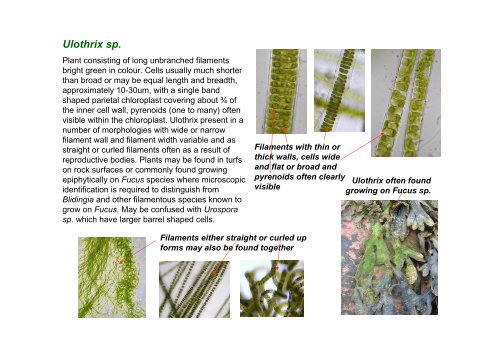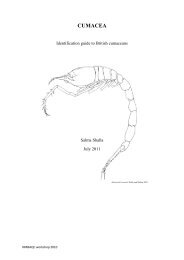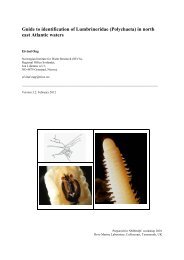s A Field Guide to the British Seaweeds - NMBAQC
s A Field Guide to the British Seaweeds - NMBAQC
s A Field Guide to the British Seaweeds - NMBAQC
You also want an ePaper? Increase the reach of your titles
YUMPU automatically turns print PDFs into web optimized ePapers that Google loves.
Ulothrix sp.<br />
Plant consisting of long unbranched filaments<br />
bright green in colour. Cells usually much shorter<br />
than broad or may be equal length and breadth,<br />
approximately 10-30um, with a single band<br />
shaped parietal chloroplast covering about ¾ of<br />
<strong>the</strong> inner cell wall, pyrenoids (one <strong>to</strong> many) often<br />
visible within <strong>the</strong> chloroplast. Ulothrix present in a<br />
number of morphologies with wide or narrow<br />
filament wall and filament width variable and as<br />
straight or curled filaments often as a result of<br />
reproductive bodies. Plants may be found in turfs<br />
on rock surfaces or commonly found growing<br />
epiphytically on Fucus species where microscopic<br />
identification is required <strong>to</strong> distinguish from<br />
Blidingia and o<strong>the</strong>r filamen<strong>to</strong>us species known <strong>to</strong><br />
grow on Fucus. May be confused with Urospora<br />
sp. which have larger barrel shaped cells.<br />
Filaments ei<strong>the</strong>r straight or curled up<br />
forms may also be found <strong>to</strong>ge<strong>the</strong>r<br />
Filaments with thin or<br />
thick walls, cells wide<br />
and flat or broad and<br />
pyrenoids often clearly<br />
Ulothrix often found<br />
visible<br />
growing on Fucus sp.




